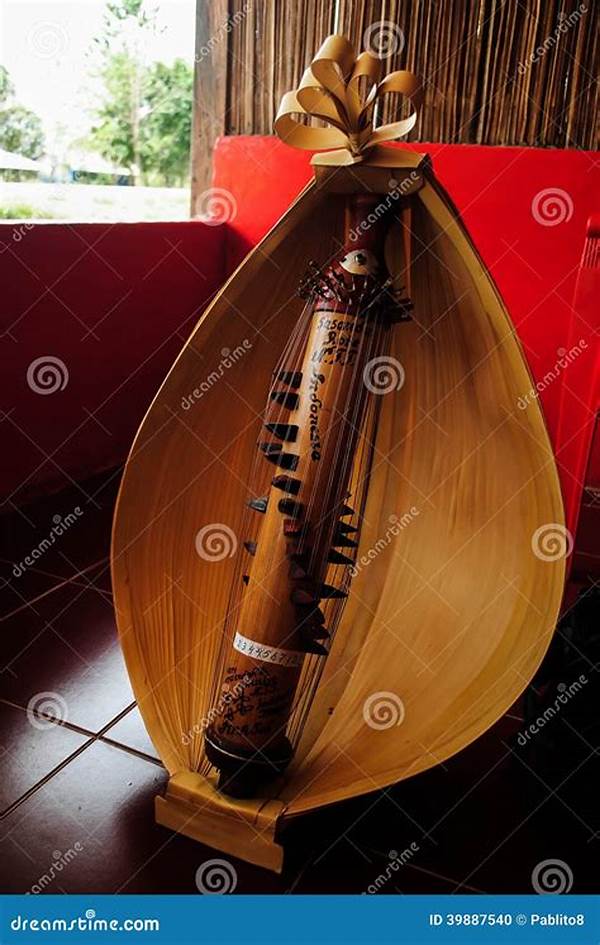Indonesia, an archipelago teeming with diverse cultures and traditions, holds a treasure trove of musical heritage waiting to mesmerize the world. Among the array of traditional music instruments, the Sasando stands out with its unique charm and melodious tones. Originating from Rote Island, part of East Nusa Tenggara, Sasando has not only captured the hearts of the local people but also piqued the curiosity of music enthusiasts worldwide. In Kupang, efforts to preserve this quintessential piece of musical history are vibrant, showcasing an unparalleled commitment to Indonesia’s rich cultural heritage.
Read More : 12-string Guitar Review With A Full Harmonic Sound
If you’ve never heard of Sasando, prepare to be enchanted. It’s more than just an instrument; it’s a testament to Indonesia’s cultural vibrancy and a symbol of the nation’s high artistic spirit. Imagine strumming a harp, plucking a guitar, and running your fingers over a piano—all at once. Sasando offers that blend of sounds, with its charming notes capable of bridging history with modernity. However, like many other forms of traditional art, Sasando faces the threat of fading into oblivion. Fortunately, Kupang has taken significant steps toward preserving this jewel of Indonesian music, ensuring that its melodious tunes continue to resonate for generations to come.
Kupang: The Heart of Sasando Preservation
The dedication to maintaining the legacy of the Sasando is not just a show of cultural pride for Kupang’s inhabitants; it is a shared responsibility that fosters self-identity and unity throughout the Indonesian archipelago. Communities in Kupang have established various cultural heritage centers where enthusiasts and visitors can learn about the remarkable history and play this extraordinary instrument. These centers also host workshops, providing hands-on experiences that deepen one’s connection to this mystical musical artifact.
Preserving Sasando in Kupang is more than just safeguarding a musical instrument; it’s about keeping a piece of history alive. Local leaders, cultural practitioners, and young musicians are actively involved in educational programs that bring attention to this cultural relic, blending storytelling with rhythm to invigorate interest and appreciation among the younger generation. Schools and cultural festivals frequently feature performances, showcasing the Sasando and inspiring many to keep the tradition alive. Such efforts transform preservation into a dynamic community endeavor, where pride in heritage becomes a cause for celebration.
The Craft of Sasando: Tuning into Tradition
The Artistry Behind Sasando
Crafting a Sasando is both an art and a science. Made primarily from bamboo and palm leaves, every piece is meticulously assembled to produce the distinct sound that the Sasando is famous for. Artisans infuse ingenuity into every detail, ensuring that the instrument not only looks magnificent but sounds heavenly. Emphasizing authentic traditional techniques, each Sasando crafted in Kupang embodies the essence of Rote Island, where the instrument has been cherished for centuries.
The Sound of Sasando: A Symphony of Heritage
The melody of a Sasando is unlike anything else. It transcends the norm, drawing listeners into a sonic tapestry that reflects the heart and soul of Indonesia. Each performance tells a story, painting vivid landscapes of history and tradition through harmonious notes. For both musicians and audiences, the Sasando offers an immersive experience that interconnects the past with the present, elevating cultural appreciation to new heights.
Modern Efforts to Preserve Sasando
Technology Meets Tradition
In a world where technology often overshadows tradition, Kupang is determined to harmonize the two by incorporating modern recording techniques and digital platforms to promote the Sasando internationally. Virtual tutorials, concerts, and workshops transcend geographical limitations, enabling a new generation of musicians to explore and appreciate this classical instrument. This innovative approach ensures that the Sasando isn’t just a relic to be admired from afar but a living, breathing part of contemporary music.
Social Media and Sasando
Social media plays a significant role in promoting the Sasando. Platforms like YouTube and Instagram are laden with videos showcasing captivating performances, tutorials, and the rich history behind the instrument. By capitalizing on the widespread appeal of digital content, Kupang leverages these platforms to engage young audiences, inspire budding musicians, and attract global attention.
Read More : A Complete Review Of A Professional Cello For International Concerts
The Future of Sasando: Inspiring Generations
Testimonies from the Heart
Through the words of musicians who have mastered the Sasando, we can appreciate its powerful influence not only as an instrument of music but as a medium of personal and cultural expression. Testimonies often reveal a deeper connection with the Sasando, highlighting personal journeys of growth, admiration for cultural heritage, and the pursuit of bringing joy to audiences worldwide. These narratives resonate with authenticity and serve as powerful affirmations that preservation efforts are indeed fruitful.
A Call to Action: Preserve and Play
To ensure that the legacy of the Sasando endures, it is crucial for both locals and global enthusiasts to continue learning, playing, and sharing its majestic sound. Engaging with this cultural asset contributes significantly to the overarching aim of cultural preservation. Whether you are a music enthusiast, a culture lover, or someone intrigued by the prospect of learning something new, experiencing the Sasando offers a unique and enriching adventure into the heart of Indonesian tradition.
Why Preserving Sasando Matters
Concluding Reflections
Sasando is indeed a unique cornerstone of Indonesia’s musical legacy. Its preservation in Kupang not only reflects a steadfast commitment to cultural heritage but also symbolizes the wider movement of keeping traditional arts alive in a rapidly modernizing world. By bridging the gap between generations, fostering intercultural connections, and igniting passion, the Sasando continues to play a vital role in promoting Indonesia’s cultural identity and enriching the global musical tapestry.
As we glance toward the future, one thing remains clear: the Sasando is not just an instrument, but a narrative—a vibrant living story of Indonesia’s past and a hopeful symphony for its future. Embrace its tale, support its melody, and let the journey of Indonesia traditional music instrument Sasando preserved in Kupang heritage inspire an everlasting echo.
